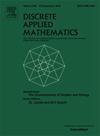The phase transitions of diameters in random axis-parallel hyperrectangle intersection graphs
IF 1
3区 数学
Q3 MATHEMATICS, APPLIED
引用次数: 0
Abstract
We study the behaviours of diameters in two models of random axis-parallel hyperrectangle intersection graphs: and . These two models use axis-parallel -dimensional hyperrectangles to represent vertices, and vertices are adjacent if and only if their corresponding axis-parallel hyperrectangles intersect. In the model , we distribute points within uniformly and independently, and each point is the centre of an axis-parallel -dimensional hypercube with edge length . The model , distributing the centres of axis-parallel -dimensional hyperrectangles within exactly as the model , assigns a length from a uniform distribution over to each edge of the axis-parallel -dimensional hyperrectangles.
We prove that in the model , there is a phase transition for the event that the diameter is at most occurring at if
where is an arbitrary small constant, and
In the model , this phase transition occurs at .
求助全文
约1分钟内获得全文
求助全文
来源期刊

Discrete Applied Mathematics
数学-应用数学
CiteScore
2.30
自引率
9.10%
发文量
422
审稿时长
4.5 months
期刊介绍:
The aim of Discrete Applied Mathematics is to bring together research papers in different areas of algorithmic and applicable discrete mathematics as well as applications of combinatorial mathematics to informatics and various areas of science and technology. Contributions presented to the journal can be research papers, short notes, surveys, and possibly research problems. The "Communications" section will be devoted to the fastest possible publication of recent research results that are checked and recommended for publication by a member of the Editorial Board. The journal will also publish a limited number of book announcements as well as proceedings of conferences. These proceedings will be fully refereed and adhere to the normal standards of the journal.
Potential authors are advised to view the journal and the open calls-for-papers of special issues before submitting their manuscripts. Only high-quality, original work that is within the scope of the journal or the targeted special issue will be considered.
 求助内容:
求助内容: 应助结果提醒方式:
应助结果提醒方式:


